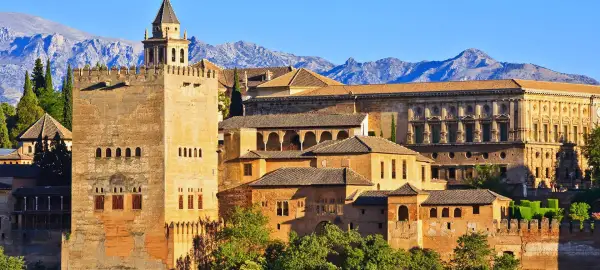Small Group Experiential Travel
Tour Code
ES6
Start
Madrid (MAD)
End
Marrakech (RAK)
Tour type
Cultural
Max Group Size
18
When To Go
Apr, May, Oct
Activity Level
2 - Moderate
Overnight in
Casablanca, Fes, Marrakech, Taroudant, Essaouira, Ouarzazate, Madrid, Sevilla, Cordoba, Granada, Ronda, Erfoud, Merzouga
- Overview
- Info & Inclusions
- Itinerary
- Map & Hotels
- Photos
- Dates & Prices
Highlights
- Toledo, Granada, Cordoba - World Heritage cities
- Madrid: City tour & Prado
- Arab, Jewish, Christian, Roman, Visigothic legacies
- Andalucia: Orange groves, flower-filled patios
- 'Imperial cities', Meknes, Fes, Marrakech
- Volubilis, Morocco's only Roman site
- Atlas Mountain vistas and charming villages
- Zagora - Gateway to Sahara
- Sunrise at Dunes du Tinfou
- Relaxed seaside town of Essaouira
Description
One look at the mountains framing the sky or the lakes that mirror any beauty that happens to be above the calm surface and we will come to understand how it feels to be in a utopia. On our Spain & Morocco tour you can explore utopia.
The elegant buildings throughout the city seem as intricately placed as the cobblestones that line the streets.
Take a simple stroll along alleyways lined with balconies supporting flowerbeds overflowing with colour and we will learn to use the word 'quaint' a little more mindfully.
Massive monasteries and cathedrals known to humble any onlooker, not only stand on the northern shores of the Mediterranean, but they are also south of the waters of Morocco.
The continuous wonderment will not disappoint, especially when we witness how the majesty of the Roman Empire endures through its many structures left behind.
The elegant buildings throughout the city seem as intricately placed as the cobblestones that line the streets.
Take a simple stroll along alleyways lined with balconies supporting flowerbeds overflowing with colour and we will learn to use the word 'quaint' a little more mindfully.
Massive monasteries and cathedrals known to humble any onlooker, not only stand on the northern shores of the Mediterranean, but they are also south of the waters of Morocco.
The continuous wonderment will not disappoint, especially when we witness how the majesty of the Roman Empire endures through its many structures left behind.
Price Includes
- Full-time Tour Leader services plus local guides at various locations.
- Breakfast and dinner (hotels & local restaurants) daily.
- All sightseeing, transport and entrance fees for sites noted as 'visited' in the detailed itinerary.
- Gratuities for local guides, drivers, restaurant staff, porters.
- Airport transfers for land & air customers arriving / departing on tour dates.
Exclusions
- International airfare to/from the tour.
- Tour Leader gratuities, lunches, drinks, personal items (phone, laundry, etc), international air taxes (if applicable), excursions referenced as 'optional'.
- Airport transfers for Land Only customers.
- Optional travel insurance (click on the "Resources" tab for details).
Trip Info
- Seasonality and Weather:
The best times to visit Iberia are spring (March-May), when the country is in bloom and waking after the winter, and fall (September/October), when the weather is warm and summer crowds have dispersed.
SPRING
Our early spring date coincides with a time of year when Iberia emerges from its long winter slumber and, while there’s still the odd shower and chilly day, the first whiff of spring is in the air, with days steadily getting milder and sunnier and the countryside awash with blossom. It can also be very peaceful time to visit, as the crowds of the peak season have not yet arrived. Flights can also cost much less than they would two months later. Our later spring date (April/May) will be a bit drier and warmer - maybe even "hot" to the south and inland - and the more popular spots will start to see some crowds.
FALL
September and October are two of the best months to visit. The weather is still warm and pleasant, and the temperatures are much more manageable than summer for sightseeing or outdoor activities. Sites generally tend to be a bit busier than one may encounter in spring, especially those places where cruise ships call, but the place still has a relaxed feel away from the coastal resort areas. A big bonus this time of year is the myriad locally-grown fruits and vegetables that find their way onto local menus.
MOROCCO
Our timing in Morocco is dictated by the need to skip the extreme summer heat common in the interior, and the cold and rainy winter weather common mountainous regions and along the coast. Our earlier spring date will enjoy comfortable temperatures throughout, though layering is the key as mornings and evenings can be chilly but then warm up nicely. Our later spring date can experience some heat at inland locations, but morning and evenings are comfortable. In this arid climate, humidity is not a factor at any time of year. - Transport and Travel Conditions:
Land transport throughout by private air-conditioned motor coach, 24-36 seats depending on ultimate group size (see 'group size'). Though we will have some full bus days (especially in Morocco) there are plenty of stops of interest. Roads are in good condition though winding on some stretches.
Spanish train journeys are comfortable (2nd class). YOU MUST BE ABLE TO MANAGE YOUR OWN BAGS ON/OFF TRAINS AND IN TRAIN STATIONS.
Please note that, due to the narrow and winding nature of the streets and the size of our vehicle, we may need to park some distance away from our hotels in Granada, Córdoba, and Rhonda and walk our luggage a short distance.
Our difficulty "Level 2" refers to the overall ambitious nature of our program, some long road journeys, some early starts, and time spent at remote locations (Morocco). Depending on season, you may also experience some heat at some locales. Much of our sightseeing is conducted on foot, with walking tours of towns & cities, medinas, archaeological sites, and museums. You must be prepared to be on your feet for several hours at a time, walking at a leisurely pace. We will also have short walks to dinner. Though our hotels all have elevators, you will also encounter stairs quite frequently during our sightseeing visits.
Am I suitable for this tour? Please refer to our self-assessment form - Accommodation:
Well-located, air- conditioned, mid-range hotels (3-4 star) throughout. All hotels have en suite bath, though some may have shower only. Porter service is usually available is Morocco (see 'inclusions'), not so likely in Iberia-you should be independent with your luggage. Single rooms are limited and likely smaller than twins. - Activity Level: 2
These are particularly busy tours that feature a lot of moving around, sometimes by train and short journeys on local transport. Walking tours of towns and cities are leisurely but you should be prepared to be on your feet for several hours. Some of our cultural trips that occur at high altitude and/or require greater independence with baggage handling (at hotels, airports, train stations) also fall into this category.
To learn more about the Activity levels, please visit our tour styles page. - Staff and Support:
Tour Leader throughout, driver, local step-on guides in various locales. - Group Size:
Maximum 18 plus Tour Leader
Download Itinerary
- Day 1:Arrive in MadridToday we arrive in Madrid and transfer to our hotel.
The capital of Spain, located in the heart of the peninsula and right in the center of the Castillian plain, is a cosmopolitan city, a business center, headquarters for the Public Administration, Government, Spanish Parliament and the home of the Spanish Royal Family.
Overnight in Madrid.
Included Meal(s): Dinner - Day 2:Madrid & The PradoThis morning we have a panoramic tour of broader Madrid, terminating at the Prado Museum for a guided tour. Our route to the museum likely takes us past Plaza Espana point and the Cervantes Monument.
Originally opened to the public in 1819, the Prado houses all of the finest works collected by Spanish Royalty as well as Spanish paintings gathered from other sources over the past two centuries. The Prado is one of the most important repositories of art in the world, including a vast collection of Italian paintings. For the purposes of our visit, however, we will concentrate on works by Spanish masters -- Velasquez, Goya, Ribera, El Greco, Zurbaran, to name a few.
After our tour, we'll head off on foot for an informal stroll up Gran Via and into the old quarter of Madrid. You'll then have free time for lunch and an afternoon of independent exploration. Your Tour Leader can help you plan your free time, with recommended shopping, other historical sites and galleries. You may want to visit the nearby Reina Sofia for the important modern art collection, including Picasso's masterpiece, "Guernica." Or visit the Museo Naval, one of the world's most important Navy Museums, to learn about the history of the Spanish Armada.
Overnight in Madrid.
Included Meal(s): Breakfast and Dinner - Day 3:Madrid: Toledo Day TripThis morning we travel to Toledo, a city with a unique blend of Arab, Jewish, Christian, Roman, and Visigothic elements. Toledo sits on a rocky promontory isolated on three sides by a looping gorge of the Tagus River. The history of several different cultures is contained within this region, represented by the houses, synagogues, churches, and mosques.
Our excursion includes a visit to the Cathedral, as well as the Santa Maria la Blanca Synagogue, which shows the influence of the Granada Moors.
We also see one of Toledo's most outstanding attractions, El Greco's masterpiece "The Burial of the Count of Orgaz" located inside the Church of Santo Tome.
After lunch and some free time in Toledo, we return to Madrid.
Overnight in Madrid.
Included Meal(s): Breakfast and Dinner - Day 4:Madrid - Cordoba: City TourToday we travel by fast train to Cordoba (+/- 2 hours), crossing the Despenaperros Mountains and the border pass between Castile and Andalucia.
During our time in Cordoba (a World Heritage City), we will gain a sense of the city's long and varied past and multicultural nature. Our tour starts at the Roman Bridge and the Calahorra Tower, an Arab defensive tower. Next we arrive at the Mezquita-Catedral, or Great Mosque of Cordoba, one of the oldest structures still standing from the time Muslims ruled Al-Andalus. The buildings on this site are as complex as the extraordinarily rich history they illustrate. Historians believe that there had first been a temple to the Roman god, Janus, on this site. The temple was converted into a church by invading Visigoths who seized Cordoba in 572. Next, the church was converted into a mosque and then completely rebuilt by the descendants of the exiled Umayyads -- the first Islamic dynasty who had originally ruled from their capital Damascus (in present-day Syria) from 661 until 750.
We visit the Alcazar fortress, built by King Alfonso XI, and containing mosaics and sarcophagi.
Finally we will have a stroll in the Jewish Quarter where the synagogue is located.
Please note: Our official meal plan for today is "breakfast & dinner"; however, due to other variables, however (such as hotel location), your Tour Leader may choose to include lunch instead of dinner today. You will, of course, be advised in advance.
Overnight in Cordoba.
Included Meal(s): Breakfast and Dinner - Day 5:Cordoba - GranadaOur tour continues to Granada, set in the heart of Andalucia with the majestic Sierra Nevada mountains as a backdrop. Conquered by the Moors in AD 711, Granada blossomed into one of Europe's wealthiest and most refined cities. The legacy of Granada's rich history and heritage remain visible throughout the city centre with its cobblestone streets and lovely plazas. In 1992 Granada celebrated the 500th anniversary of the Christian re-conquest by the Catholic Monarchs, Ferdinand, and Isabella.
On arrival we visit the Royal Chapel, featuring tombs carved out of marble by the Tuscan sculptor Domenico Fancelli. As both Queen Isabel and King Fernando died before the Royal Chapel was finished, they were first buried in the Friary of San Francisco in the Alhambra. They were then later moved to the chapel once it had been completed, and buried alongside King Felipe and Queen Juana. Although their original idea was for all future Spanish Kings and Queens to be buried here, this did not happen as the monastery in El Escorial was used instead.
Overnight in Granada.
Included Meal(s): Breakfast and Dinner - Day 6:Granada: The AlhambraThe focus of our sightseeing today is Granada's main attraction, the Alhambra, a mighty fortress that houses an extraordinarily delicate and beautiful Moorish palace begun in the 13th century. This was the palace of the Nasrid Sultans, rulers of the last Spanish Moorish Kingdom. A fantasy of "lace in stone" surrounded by arabesque gardens and fountains, it affords superb views of the Old Quarter and Sacromonte, a mountain occupied by gypsy cave dwellers. In many ways, the Alhambra represents the Moorish concept of life itself -- something glorious to be ennobled by learning and enlivened by every kind of pleasure.
We also visit the nearby Generalife Gardens.
The balance of the day is at leisure for independent exploration, or you can join your Tour Leader on an informal stroll in the city's old Moorish quarter of the Albaicin.
Overnight in Granada.
Included Meal(s): Breakfast and Dinner - Day 7:Granada - Reserva Tauro - Ronda: Town TourWe continue our tour (by road) to Ronda, a historic town located on a towering plateau in the mountains of Malaga Province.
En route we visit Reserva Tauro, a 500 acre bull and horse breeding farm. Here we have the opportunity to get close to bulls and gain an understanding of the culture without attending a bull fight. Of course this cultural/historical practice is controversial, but the farm does a good job in presenting bull fighting in an even, objective way without in any way promoting or excusing it.
In Ronda, we will walk around the old town where you will learn the origins of this ancient town where Romans, Arabs, and Christians left their traces. We'll visit the Casa Museo Don Bosco, which offers a unique glimpse into the life and work of Saint John Bosco, a 19th-century Italian Catholic priest known for his work with young people. We'll explore the museum's collections, which include personal items of Don Bosco, historical documents, and artifacts related to his work.
Ronda is of course famous for its dramatic escarpments and views, and for the deep El Tajo gorge that carries the Rio Guadalevin through its centre. We suggest a walk to the 18th century Puente Nuevo 'new' bridge, which straddles the 100m/328 ft chasm below, for its unparalleled views out over the Serrania de Ronda mountains.
Overnight in Ronda.
Included Meal(s): Breakfast and Dinner - Day 8:Ronda - Pileta Caves - Olive Oil Tour - SevillaToday we travel to Seville via a stop at the well-preserved rock paintings at the Pileta Caves (walking required on wet stone with no hand rails - speak to your leader for further guidance). The 25,000 year old Neolithic and Paleolithic drawings of black, ochre, and red are mostly just lines or patterns, but there are also horses, goats, cattle, and a rare giant fish, made from a mixture of clay and fat. This is not a well-developed tourist attraction; you must be steady on your feet and prepared for some slow walking.
We then follow the route known as "the Route of the White Villages" for the singularity of the scenery. The villages -- Pueblos Blancos -- are a series of whitewashed towns and villages in the northern part of the provinces of Cádiz and Málaga, mostly within the Sierra de Grazalema Natural Park. These charming settlements feature whitewashed houses festooned with pots of colourful flowers, mountain vistas, and traces of the Islamic and Christian past.
For a bit of a break we stop briefly in the White Town of Grazalema, a white hill down nestled in Grazalema National Park, before continuing to a visit to one of the region's olive oil producers for a tour and lunch (included instead of dinner today). The region is renown for extra virgin olive oil, which transmits all the aroma, the flavour, and the essence of the olive groves of Zahara de la Sierra. The process is difficult and extreme, with steep slopes which require manual caretaking and harvesting; the reward is a very fruity, sweet, and gentle flavour partly due to high rainfall in the area. We will learn all about this process and have a chance to taste both the oil and the wine also made locally. Our visit will culminate with a lunch typical of the region with an assortment of tapas, local cheeses, fruits and other sweets (vegatarians are well-catered for).
After a relaxing lunch, we proceed to Sevilla arriving late afternoon. Though we don't include dinner this evening, our hotel is well-placed and your Tour Leader will provide suggestions for your free time.
Overnight in Sevilla.
Included Meal(s): Breakfast and Lunch - Day 9:Sevilla: City TourSeville, a vibrant tapestry of Andalusian charm, is the fourth-largest city in Spain and the cultural heart of the region. Its picturesque streets are lined with restored Moorish architecture, fragrant orange groves, and flower-filled patios. The city's lively atmosphere is further enhanced by the rhythmic sounds of castanets, a hallmark of Seville's flamenco heritage.
During our visit, we'll immerse ourselves in Seville's rich history and architectural wonders. The Seville Cathedral, the largest Gothic cathedral in the world, boasts stunning stained glass windows, a magnificent choir, and numerous chapels. (Time-permitting) ascend the iconic Giralda Tower for breathtaking panoramic views of the city.
Step back in time at the Alcázar Palace, a UNESCO World Heritage Site and one of Europe's oldest royal residences. Explore its intricate Moorish architecture, lush gardens, and grand halls.
Along the banks of the Guadalquivir River, we'll encounter historic landmarks such as the Maestranza Bullring, a symbol of Seville's bullfighting tradition, and the Torre del Oro, a 13th-century watchtower.
For a contemporary touch, admire the Monument to Tolerance by Eduardo Chillida, a striking sculpture that symbolizes peace and understanding.the Guadalquivir riverbank and view historic monuments like the Maestranza Bullring, the Torre del Oro, and the Monument to the Tolerance by Eduardo Chillida.
Overnight in Sevilla.
Included Meal(s): Breakfast and Dinner - Day 10:Sevilla - Tarifa, Spain - Tangier, MoroccoToday we travel by road to the Spanish port of Tarifa from where we ferry across the Strait of Gibraltar to Africa and the Moroccan city of Tangier.*
Tangier is a fascinating Moroccan city to visit. It has many of the things that travellers love -- a sense of exotic mystery, interesting history, beautiful vistas, unspoiled beaches, and friendly people. Tangier is an interesting mix of north Africa, Spain, Portugal and France. Upon arrival we'll have a tour of this quickly growing and very colourful city.
* In the event that the tour runs with a small group, it may be more expedient for us to fly from Sevilla to Morocco instead. Depending on ever-changing air schedules, it is also possible that our stay in Sevilla could be extended by a day with a flight direct to Casablanca the following day. This potential situation will become clearer closer to departure.
Overnight in Tangier.
Included Meal(s): Breakfast and Dinner - Day 11:Tangier - CasablancaToday we travel by road to Casablanca with a stop for lunch en route.
Casablanca is believed to have been a Phoenician settlement and later a Berber town. It was conquered by the Almohads in 1188, and developed by Sutlan Abd el-Moumen as a port. In the 14th century the Portuguese established a settlement here on the site of the village of Anfa, but when it became a pirates' base in 1468, they destroyed it, repeating this act in 1515. The Portuguese reestablished themselves in the late 16th century, renaming the town Casa Blanca, staying until 1755, when an earthquake destroyed the settlement.
Overnight in Casablanca.
Included Meal(s): Breakfast and Dinner - Day 12:Casablanca - Rabat - FesThis morning we visit the Hassan II Mosque, a glorious structure believed to be only second in size to Islam's most important site, Mecca in Saudi Arabia. The mosque was inaugurated in August 1993, the culmination of five years of intensive labour by over 30,000 workers and craftsmen. Non-Muslims may enter as part of a guided tour.
From Casablanca we travel to Rabat, Morocco's third oldest Imperial City and modern capital. Among the sites in Rabat that we will visit are the the Hassan Tower and the Mohammed V Mausoleum. Leaving Rabat we travel to Fes arriving in time for dinner.
The historic city of Fes lies in the Oued Sebou basin, astride the traditional trade route from the Sahara to the Mediterranean and the path from Algeria and the Islamic heartland beyond. For centuries the dominant axis within Morocco was of Fes and Marrakech, two cities linked by their immense power and rivalry. Fes is still seen as the spiritual and cultural capital and holds an enduring fascination for visitors with one of the largest historic medinas full of monuments reflecting the different periods of Morocco's imperial past.
Overnight in Fes.
Included Meal(s): Breakfast and Dinner - Day 13:Fes - Volubilis - Meknes - FesThis morning we visit the impressive site of Volubilis, the best-preserved Roman site in Morocco. Situated on the ledge of a long plateau, the dramatic site was once one of the Roman Empire's most remote outposts. Our local guide here will take you on tour of the site; we also allow free time for photographs.
We also see the sacred town of Moulay Idriss (photo stop only). Moulay Idriss is a dramatic sight, houses and mosques piled up around two rock outcrops, with the 'zaouia,' or sanctuary, in between.
We continue to Meknes, Morocco's youngest Imperial City. We feature the Bab El Mansour gate dating from 1752, complete with its Corinthian columns. The city was built by a massive army of slaves, both Moroccan and Christian, and the Sultan was in particular famed for his barbaric treatment of these people, supposedly interring them in the walls. The city contained within it all that was necessary for such a large population and military machine, with store houses, stables, armouries, exercise areas, gardens and ponds.
We return to Fes.
Overnight in Fes.
Included Meal(s): Breakfast and Dinner - Day 14:Fes: City TourToday we will have a walking tour of Fes El Bali, the extraordinary medieval walled city. Once inside the gates of this great spectacle, you will see an entirely different view of life in Morocco. In contrast to the well-planned Ville Nouvelle, the old city is a labyrinth of alleys and lanes lined with shops, mosques, homes and schools. In 1980 UNESCO designated the medina a World Heritage Site.
Our guide will take us to the medina to view the market shops, or suqs. Everything from food to clothing can be purchased. We will see the famous dying works with the brightly coloured cloth hanging to dry. A visit to the Royal Palace, several mosques, theological schools, and shops where we can see craftsmen tailoring their work will round out the day's tour. Today's walk is an amazing look into the life of the Moroccan city dweller where little has changed over the centuries.
Overnight in Fes.
Included Meal(s): Breakfast and Dinner - Day 15:Fes - ErfoudWe have a morning departure for the Middle Atlas, a region of folded mountains and high, windswept plateaux, vast forests of cork oak and cedar, and lakes and streams full of trout. This is Berber country and sheep and goat-rearing is the main occupation of these resilient, friendly people. We drive via the Berber villages of Imouzzer du Kandar; Ifrane, a fairy-tale town unlike any other in Morocco with white-walled French-style villas with steep red roofs and gables. As the altitude increases, we come to a bare, arid, sandy plateau with another range of mountains in the distance.
We continue to Erfoud, an attractive town -- red and sandy, exuding desert ambiance.
Overnight in Erfoud.
Included Meal(s): Breakfast and Dinner - Day 16:Rissani & Merzouga DunesThis morning we journey to the historic 8th century caravan town of Rissani to visit the Tafilalt Oasis. The first capital of the Tafilalt and the last stop on the caravan routes south, Rissani has a special place in Moroccan lore. The ruling Alaouite dynasty (from whom Morocco's current ruler, Mohammed VI, is a descendant) launched its bid for power here before triumphing finally in Fes and Marrakech. Today, a quarter of Rissani's population still inhabits a large 17th-century ksar in the center of town.
Later this afternoon we drive by 4WD vehicle to Merzouga to witness sunset over the dunes. We have time to explore the dunes on foot, or by camel! This is a magical Saharan landscape, with huge drifting expanses of sand dunes reaching heights of more than 45 metres (148 ft). Their colour shifts from pink to gold to red to white depending on the time of day.
Overnight at Merzouga.
Included Meal(s): Breakfast and Dinner - Day 17:Merzouga - Todra Gorge - OuarzazateThis morning, we embark on a journey to the awe-inspiring Todra Gorge, a natural wonder nestled in the heart of Morocco’s High Atlas Mountains. This dramatic geological formation is a deep, narrow canyon carved by the relentless force of the Todra River over millennia. Towering limestone cliffs, some reaching heights of over 300 meters (984 feet), rise majestically on either side, creating a breathtaking spectacle. At its narrowest point, the gorge constricts to a mere 20 meters (66 feet), offering a truly humbling experience as you walk along the canyon floor, dwarfed by the sheer scale of the surrounding rock formations.
Later, we'll wind our way through the dramatic southern slopes of the High Atlas Mountains. The road will take us past stunning vistas of rugged peaks, fertile valleys, and traditional Berber villages clinging to the mountainside. En route, we'll make a captivating stop at the Kasbah Skoura, a magnificent fortified city of clay and adobe. This ancient oasis town, with its labyrinthine alleyways and grand kasbahs, offers a glimpse into Morocco's rich history and cultural heritage. Continuing our journey, we'll arrive in the vibrant city of Ouarzazate, often referred to as the "Hollywood of Africa." This bustling desert metropolis is renowned for its stunning desert landscapes and its role as a backdrop for numerous international film productions..
Overnight in Ouarzazate.
Included Meal(s): Breakfast and Dinner - Day 18:Ouarzazate - Ait Benhaddou - TaroudanntOur first visit this morning is the Kasbah Taourirt, once belonging to the famous El Glaoui governors. We then proceed to the kasbah of Ait Benhaddou, one of the most spectacular sites in Morocco. The site, which has received extensive renovations from UNESCO, towers high above the El Mellah River and has some of the most highly decorated dark red pise walls. We arrive in the new village on the west bank of the river and proceed to cross the river, usually with an entourage of local children.
After a brief tour and time for independent exploration, we continue our journey toward Taroudannt through the Souss Valley. The area is rich in agriculture, producing oranges, bananas, tomatoes and other crops.
Overnight in Taroudannt.
Included Meal(s): Breakfast and Dinner - Day 19:Taroudannt: City TourAs the capital of the Souss Valley, Taroudannt has traditionally been an important staging post in the Trans-Sahara caravan routes. The old city is surrounded by nearly 5 km (3 miles) of rich red-ochre walls. The walls, considered by many to be the best preserved in Morocco, give the town an elegant feeling. This morning we have a caleche (horse-drawn carriage) ride around the walls of the city before beginning our walking tour of the suq area. The town is famous for its two suqs: the Souk Arabe and the Marche Berbere. The former specialises in handicrafts and jewelry; the later is famous for house-wares, spices, wooden objects and furniture.
This afternoon is free for you to explore on your own. You may wish to spend more time in the bazaar or take a walk around the impressive city walls and bastions.
Overnight in Taroudannt.
Included Meal(s): Breakfast and Dinner - Day 20:Taroudannt - Taghazout - EssaouiraThis morning we travel toward the Atlantic coast and make a (possibly lunch) stop in the small coastal town of Taghazout, a traditional fishing village where blue boats line the beach. Each morning the fishermen make their way out to the ocean to catch fish that is sold fresh later that day; the colour scheme of blue and white boats is echoed by the houses in the village. Taghazout is a popular place for surfers and, despite extensive resort development, still has a laid-back vibe.
From here we travel northward to the fortified, whitewashed fishing village of Essaouira. Once a pirate community, the town is located on a rock promontory overlooking the sometimes raging Atlantic Ocean. There was a small Phonenician settlement at Essaouira, previously called Magdoura or Mogador, a corruption of the Berber word 'Amegdul,' meaning ‘well-protected'. The Romans were interested in the purple dye produced from shellfish which they used to colour the robes of the rich.
Orson Welles stayed here for some time, filming part of Othello at the Skala. In the 1960s Essaouira had a brief reputation as a 'happening place', which attracted hippies, notably the rock star, Jimi Hendrix. Before dinner you may want to stroll along the beach and/or visit the colourful fish market.
Overnight in Essaouira.
Included Meal(s): Breakfast and Dinner - Day 21:Essaouira: Walking TourEssaouira is one of Morocco's most charming towns. Old Mogador was occupied in the 15th century by the Portuguese who built the fortifications around the harbour. These impressive ramparts still give the city a fortified look.
Today you will be guided on a leisurely walking tour of this coastal city. The port area offers an interesting look into the fishery industry of Morocco, and the jewellery suq offers some of the best silver items available. You may also wish to visit one of the many art galleries or visit the Musee Sidi Mohammed Ben Abdallah which features excellent displays of marquetry and handicrafts. Be sure to visit the Marchee d'espices (spice market) where you can purchase your cooking spices or pick up some "cures" for whatever ails you.
Overnight in Essaouira.
Included Meal(s): Breakfast and Dinner - Day 22:Essaouira - MarrakechToday we travel from Essaouira inland to Marrakech. As we approach Marrakech, the scenery becomes flatter and greener, as the city is the centre of a large palmerie oasis. You will notice an abundance of the pink mud-brick buildings amid this tree-filled city. With it's unique character and charm, Marrakech lures visitors with a hospitable climate and superb location.
This evening we visit the famous Djemma el-Fna in the centre of the city. The Djemma el-Fna is like nowhere else in North Africa. This "Assembly of the Dead," offers a spectacle that is a must-see when visiting Morocco. In the busy square you will witness a carnival of musicians, snake charmers, acrobats, story-tellers, witch doctors, dentists, clowns, monkey's and the like. The enduring smells of the Djemma's food stalls, piled high with platters of specialty cuisine, are well worth a visit just for the experience.
Overnight in Marrakech.
Included Meal(s): Breakfast and Dinner - Day 23:Marrakech: City TourMarrakech is one of the world's most enchanting cities. The city is situated on a lush palmerie and city dates to the Almoravid Dynasty circa 1670. Founded by Youssef bin Tachfine, the city became the dominant centre of Morocco. Our morning walking tour takes us to the Koutoubia, nearly 70 m (230 feet) high and emulating the classic Moroccan design. We will also take a short walk through the Mellah or Jewish quarter.
This afternoon we allow free time to visit one of the many gardens -- the Majorelle Garden is recommended. Within the gardens is an excellent museum displaying a collection of Berber objects originating from diverse regions of Morocco, from the Rif to the Sahara.
Overnight in Marrakech.
Included Meal(s): Breakfast and Dinner - Day 24:DepartureDeparture from Marrakech.
BON VOYAGE!
Included Meal(s): Breakfast
Regions Visited: North Africa and Western Europe
Countries Visited: Morocco and Spain
Countries Visited: Morocco and Spain
*The red tour trail on the map does not represent the actual travel path.
The following is a list of sample hotels at some locations included on this tour. The hotels shown here are meant to provide a general sense of the standard of hotel we usually aim for; they are not necessarily confirmed for your chosen departure.
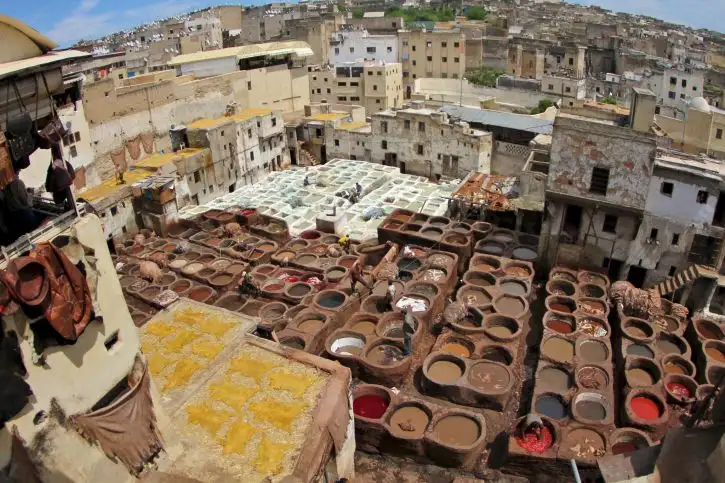
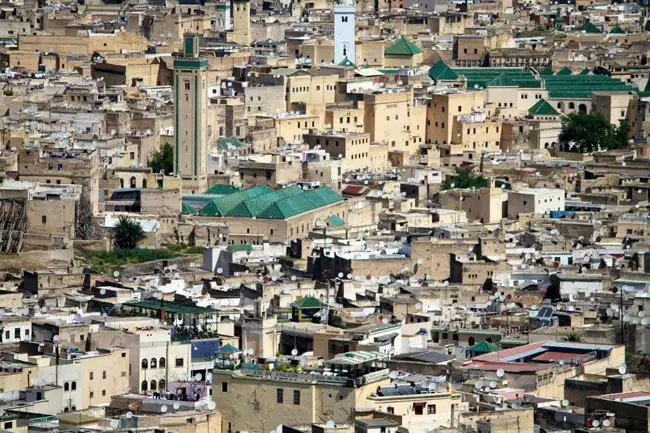
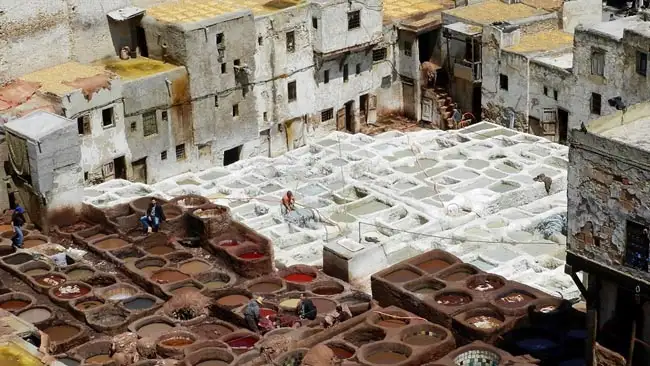
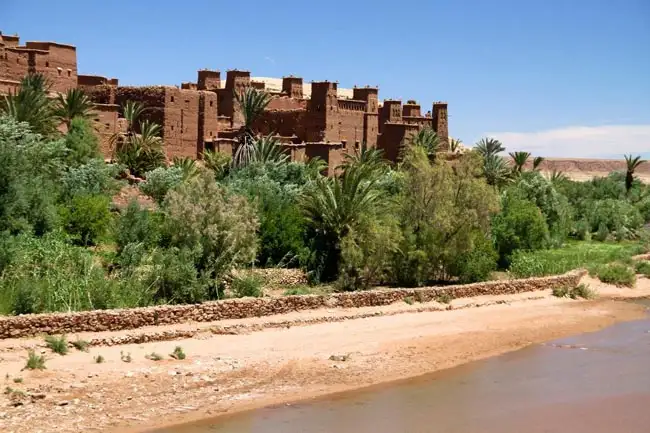
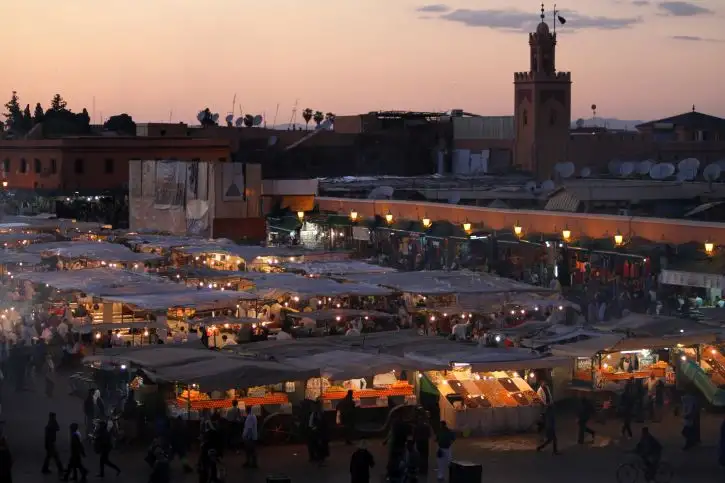
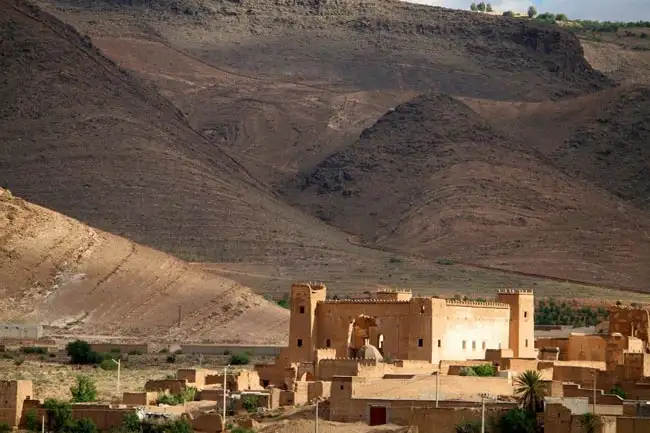
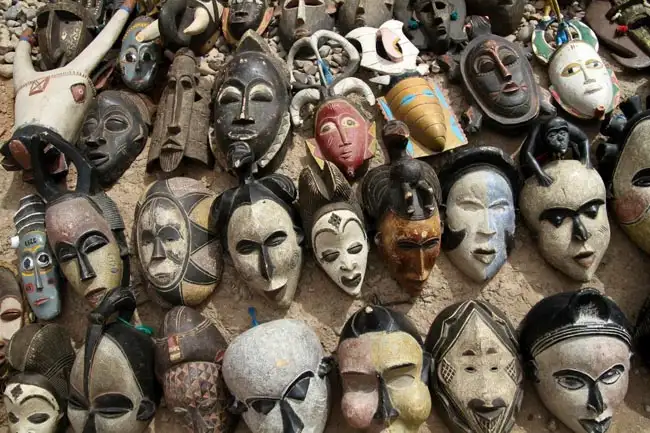
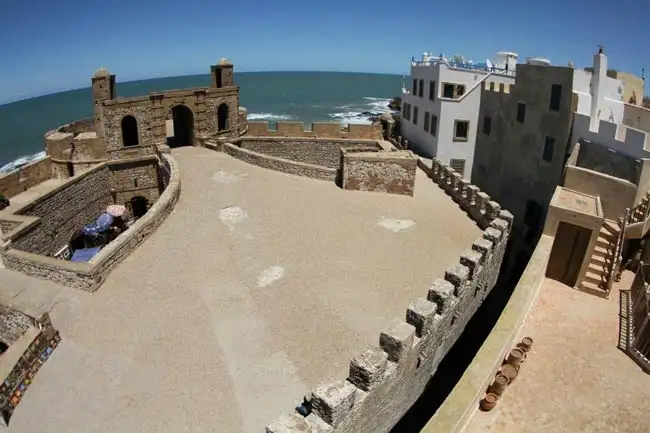
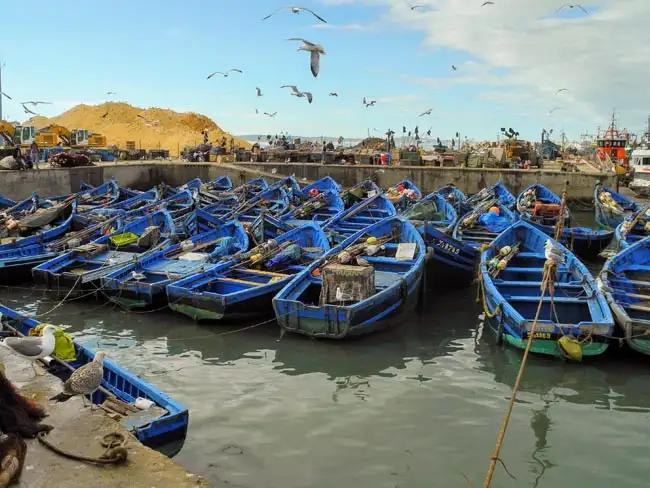
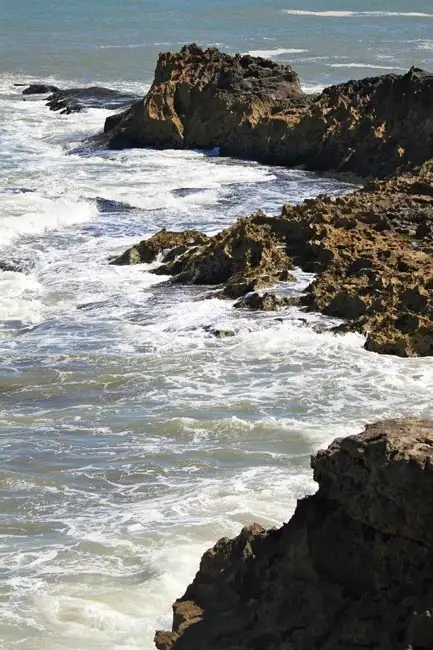
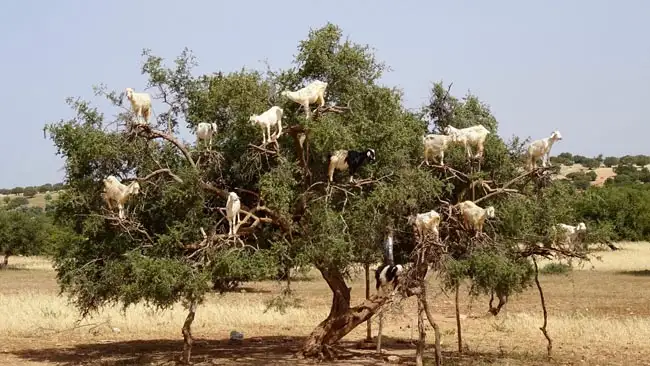
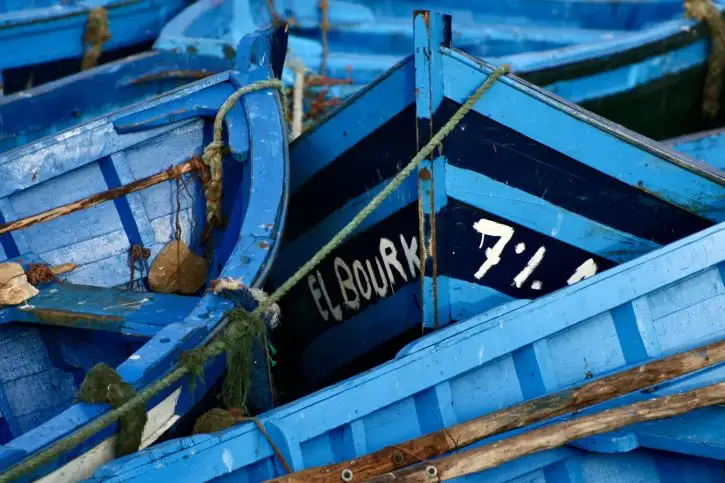
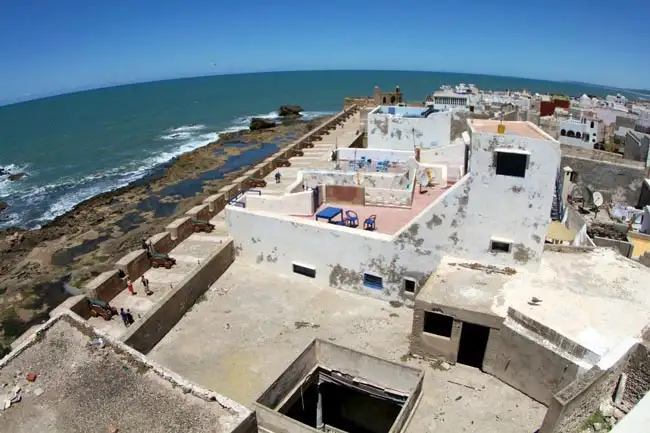
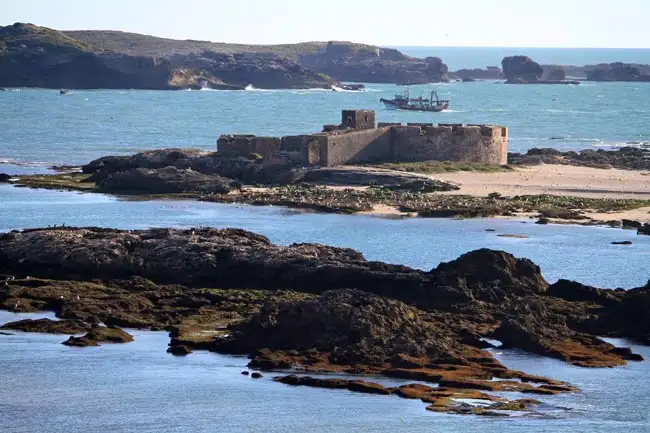
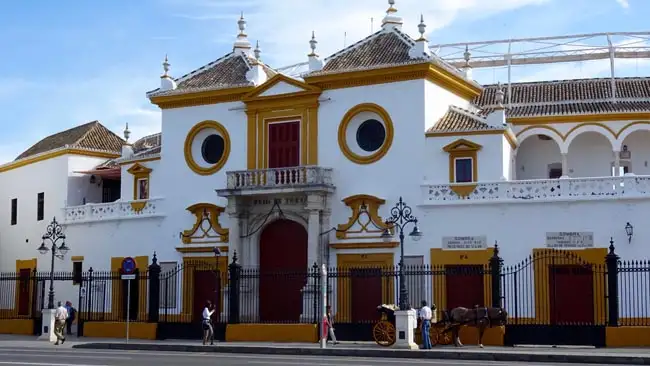
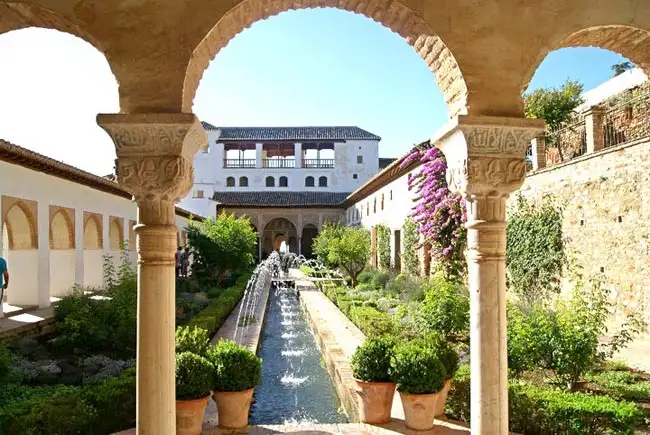
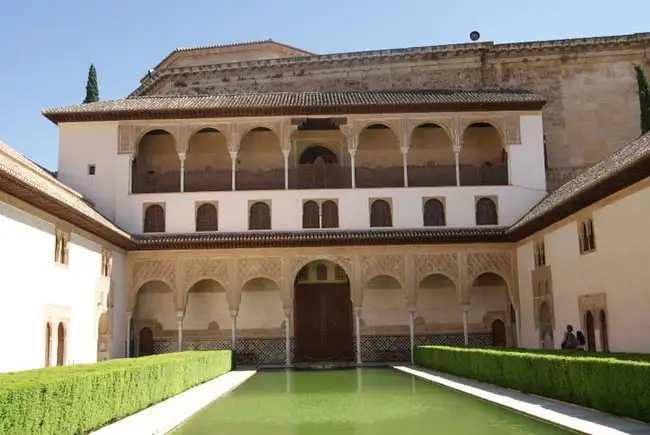
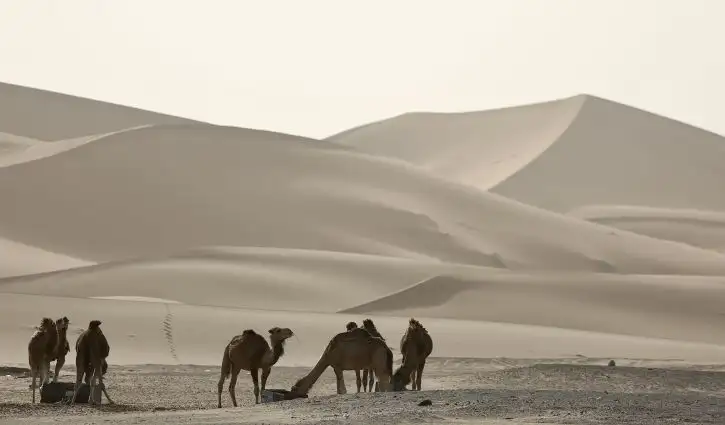
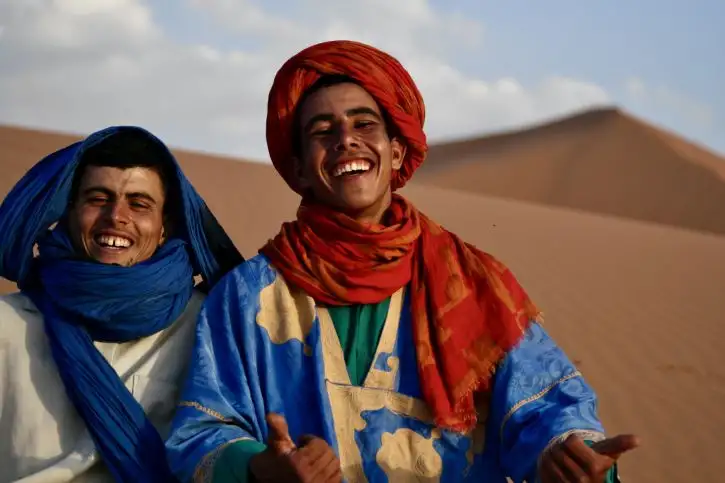
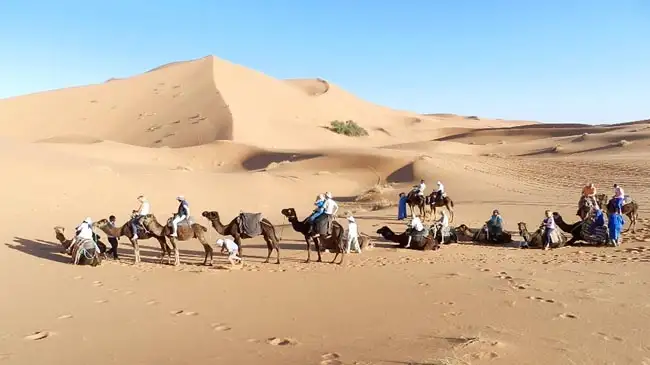
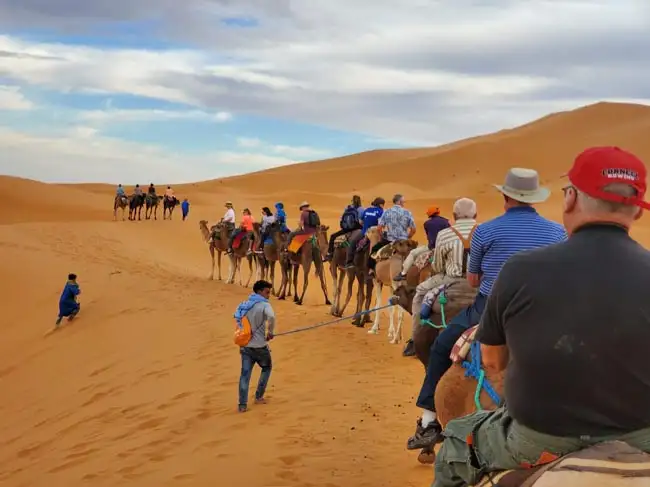
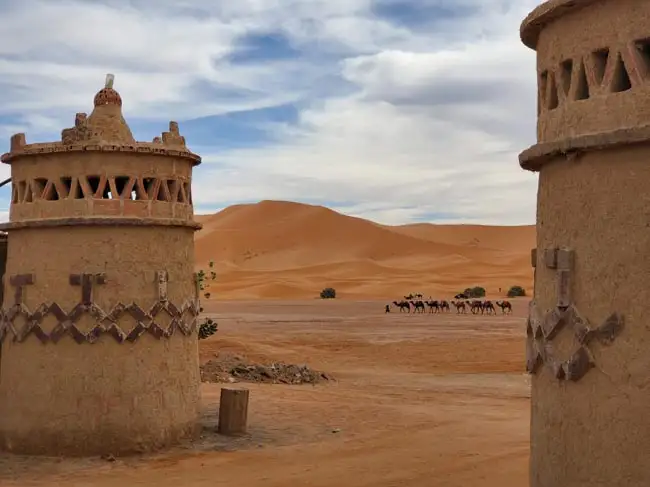
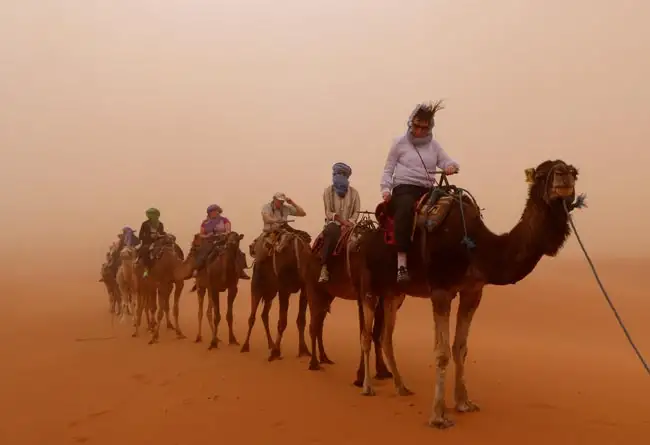
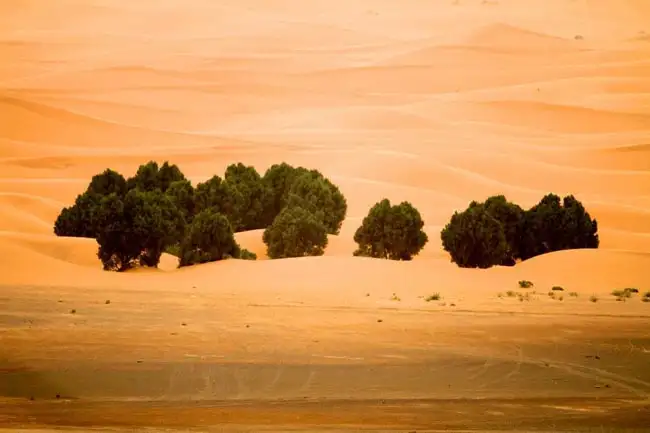
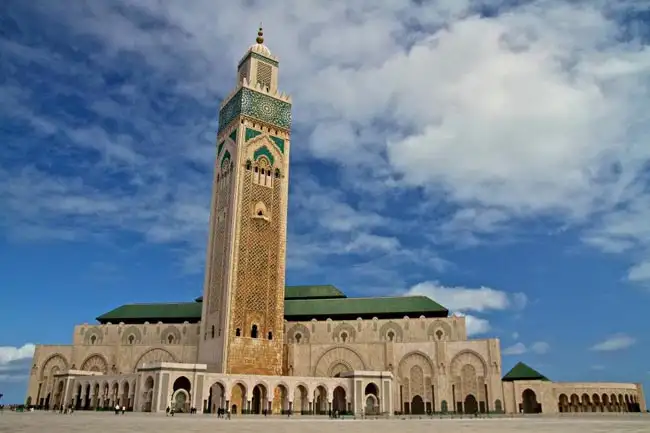
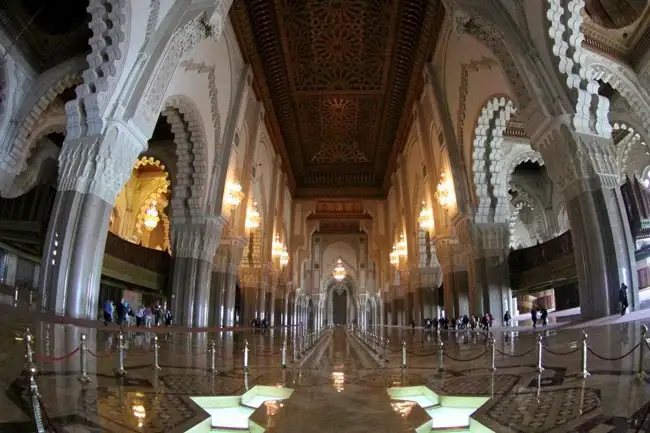
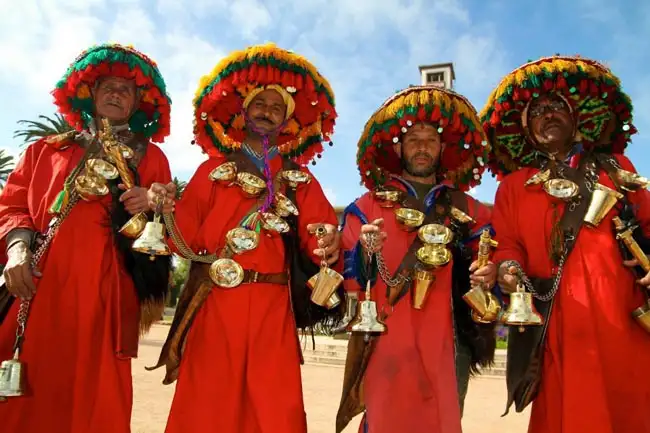
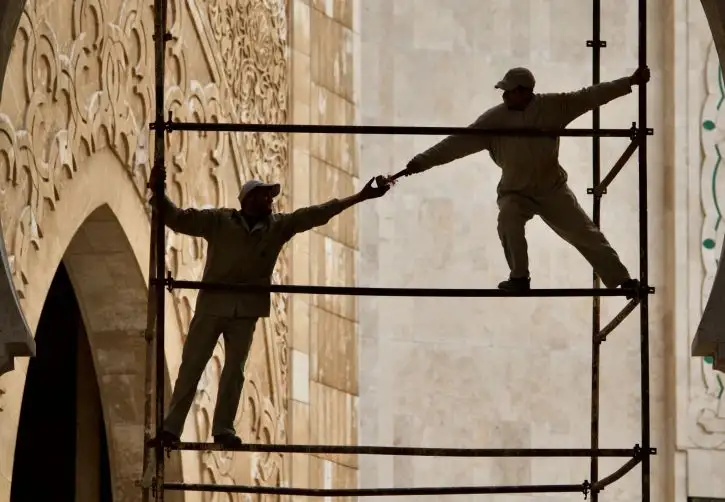
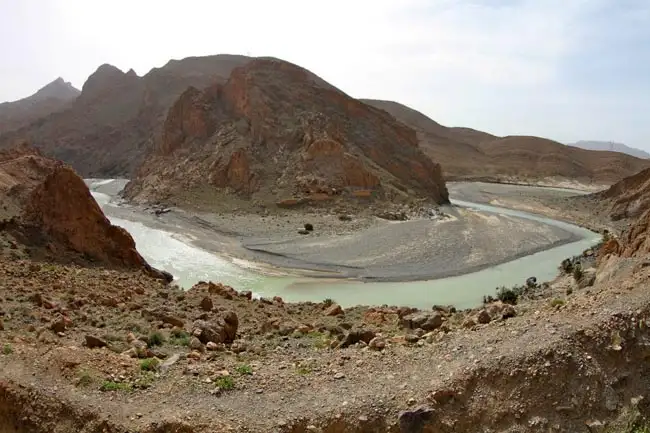
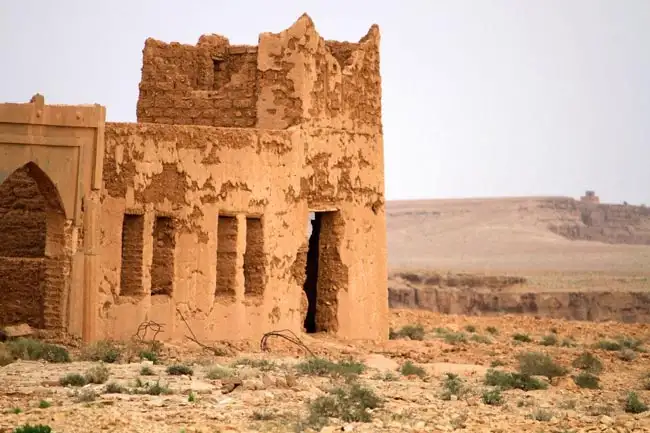
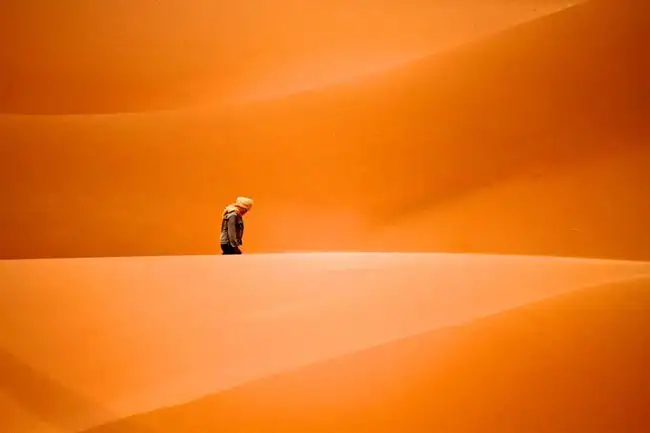
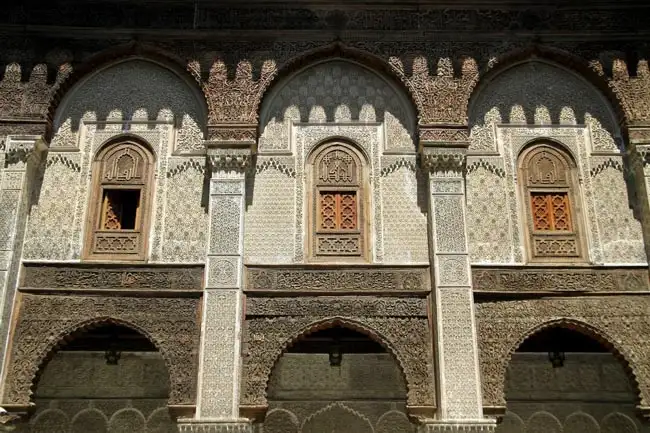
Excellent
Overall Rating
4.6
Extend Your Trip
This tour is part of a series that can be upgraded to make for a longer trip.
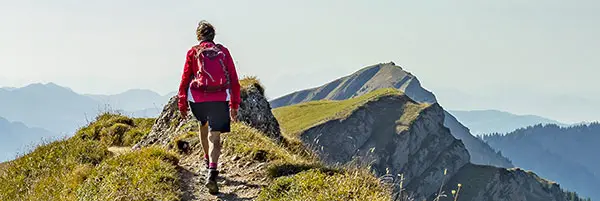
Fast and easy
Book this tour
Book your unforgettable adventure today! For any questions or advice, don't hesitate to contact us.
Have questions?
Contact Us
1-800-665-3998
- Final payment is due 90 days prior to departure.
- A non-refundable $500 USD deposit is payable at the time of booking
- Optional Single Supplement: $1280 USD (number of singles limited).
- Transferring to another tour or tour date is only permissible outside of 120 days prior to departure and is subject to a $100 USD change fee. (Read our cancellation policy for more info.)
Prices below are per person, twin-sharing costs in US Dollars (USD). Pricing does not include airfare to/from the tour and any applicable taxes. Get general information on flights to/from the tour.
Choose your departure date:
Frequently Asked Questions
- What is the maximum number of participants on a trip?Most of our tours carry a maximum of 18 participants; some tours (ie hiking tours) top out at 16. In the event that we do not achieve our minimum complement by our 90-day deadline, we may offer group members the option of paying a "small-group surcharge" as an alternative to cancellation. If all group members agree, we will confirm the trip at existing numbers; this surcharge is refundable in the event that we ultimately achieve our regular minimum. If the small group surcharge is not accepted, we will offer a refund of your deposit or a different trip of your choice.
- Can I extend my tour either at the beginning or end? What about stopovers?Yes, you can extend your tour either at the beginning or the end and we can book accommodation in our tour hotel. Stopovers are often permitted, depending on air routing. Stopovers usually carry a "stopover" fee levied by the airline.
- How do I make a reservation? How and when do I pay?The easiest way to make a reservation is via our website; during office hours, you are also more than welcome to contact us by telephone.
A non-refundable deposit is payable at the time of booking; if a reservation is made within 90 days, full payment is required. Some trips require a larger deposit. If international airline bookings require a non-refundable payment in order to secure space or the lowest available fare, we will require an increase in deposit equal to the cost of the ticket(s).
Early enrolment is always encouraged as group size is limited and some trips require greater preparation time.
Once we have received your deposit, we will confirm your space and send you a confirmation package containing your trip itinerary, any visa/travel permit related documents, invoice, clothing and equipment recommendations, general information on your destination(s), and forms for you to complete, sign and return to us. Your air e-tickets (if applicable), final hotel list, final trip itinerary, and instructions on how to join your tour, will be sent approximately 2-3 weeks prior to departure. - What about cancellations, refunds, and transfers?Please review our cancellation policy page for details.
- I am a single who prefers my own room. What is a single supplement?All of our tours have a single supplement for those who want to be guaranteed their own room at each location.
This supplement is a reflection of the fact that most hotels around the world do not discount the regular twin-share rate for a room by 50% for only one person occupying a room. Most hotels will give a break on the price, but usually in the range of 25-30% of the twin-share rate. This difference, multiplied by each night, amounts to the single supplement.
The conventional amount can also vary from country to country and some destinations are more expensive than others for single occupancy. In order to be "single friendly," the supplements we apply are not a profit centre for us and we do our best to keep them as reasonable as possible.
On most tours we limit the number of singles available, not to be punitive, but rather because many hotels allow for only a limited number of singles; some smaller hotels at remote locations also have a limited number of single rooms available.
Please note that most single rooms around the world are smaller than twin-share rooms and will likely have only one bed. - Do you have a shared accommodation program?Yes! If you are single traveller and are willing to share, we will do our best to pair you with a same-gender roommate. On most of our tours, if we fail to pair you, we will absorb the single supplement fee and you will default to a single room at no extra charge. At some destinations, however, where single rooms are not significantly discounted, or not at all, we may apply a "mandatory" single in the event that we cannot find you a share partner. This is usually 50% of the usual supplement, but can be as much as 100%. If applicable, this proviso will be noted on each tour page on this website, on your invoice, and in our tour date/price book (available for download under "Resources").
Please choose a departure date!
